#ROUND 3
Explore tagged Tumblr posts
Text
Round 3 - Reptilia - Columbiformes




(Sources - 1, 2, 3, 4)
Our next order of birds are the Columbiformes, containing birds commonly known as either “doves” or “pigeons”. It contains one family, Columbidae, with 51 genera divided into 353 species, one of the most diverse families of birds.
Columbiformes are stout-bodied birds with small heads, short legs, relatively short necks, slender bills, and often fleshy ceres. There is no scientific distinction between “doves” and “pigeons”; some columbiformes are simply commonly called “doves” while others are called “pigeons”. Most species have large wings and strong flight muscles, and are some of the strongest fliers of all birds. They are largely herbivorous, feeding on seeds, fruit, and/or foliage. A few species will also eat worms, snails, and insects. Species that feed on seeds tend to be dully colored, while species that feed on fruit are usually colorful. Columbiformes are distributed in almost every terrestrial habitat on Earth, except for the driest areas of the Sahara Desert, Antarctica and its surrounding islands, and the high Arctic.
Columbiformes are known for building rather flimsy nests, using sticks, vegetable matter, and other debris, which may be placed on trees, on rocky ledges, or on the ground, depending on species. The female may either build the nest, with material gathered by the male, or the male builds the nest by himself. A few species nest colonially, others nest in aggregations. Most lay a clutch of one or two white eggs at a time which take 11-30 days to hatch. Both parents care for the young, and both sexes produce "crop milk" to feed their young. This fluid is secreted by a sloughing of epithelial cells from the lining of the crop. Unfledged baby Columbiformes are called “squabs” and are generally able to fly by five weeks old. Fledglings are called “squeakers” once they are weaned, and leave the nest after 25–32 days.
Columbiformes has origins dating back to the Cretaceous, though they did not begin diversifying until after the K-Pg extinction event. Modern Columbids emerged in the Early Miocene.

Propaganda under the cut:
The Domestic Pigeon (Columba livia domestica) was domesticated from the Rock Dove (Columba livia) in the Mediterranean region at least 2000–5000 years ago. They were domesticated for food, ritual sacrifices, and as messengers. One breed, the Homing Pigeon (also known as the Carrier Pigeon), was especially used as a messenger as it was selectively bred for its ability to find its way home over extremely long distances. Today, pigeon fanciers use Homing Pigeons for long-distance pigeon racing. Released or abandoned Homing Pigeons have turned into large feral populations all over the world, usually in large cities as the domestic birds still depend on humans for food. As the world’s oldest domesticated bird, they are still popular pets, and the bird species most suited for a pet lifestyle, with around 800 breeds in a variety of different shapes, colors, and sizes.
Cher Ami was a male Homing Pigeon known for his military service during World War I. The Domestic Pigeon was awarded a Croix de Guerre Medal, a gold medal from the Organized Bodies of American Racing Pigeon Fanciers, and posthumously became the second recipient of the Animals in War & Peace Medal of Bravery. His last message saved 194 men who were caught between the Germans and a barrage of friendly fire. Like the two pigeons who had been released before him, Cher Ami was shot down by the Germans. But after several seconds, he managed to take flight again. Cher Ami made it 40 km (25 miles) back to his loft in just 25 minutes, with a gunshot wound through his breast, a blinded eye, and one leg hanging on by a tendon. The Lost Battalion was saved, while medics worked to save Cher Ami’s life. When he recovered enough to travel, the now one-legged bird was put on a boat to the United States, where he retired for two months before his death.
Some populations of European Turtle Dove (Streptopelia turtur) migrate over 5,000 km (3,107 miles) between northern Europe in the summer and tropical Africa in the winter.
The largest living pigeon is the turkey-sized Victoria Crowned Pigeon (Goura victoria) (see gif above) of New Guinea. It is typically 73 to 75 cm (2.4 to 2.5 ft) long, with an average weight of 2.39 kg (5.3 lb). Some specimens may exceed a length of 80 cm (2.6 ft) and a weight of 3.5 kg (7.7 lb).
Meanwhile, the Plain-breasted Ground Dove (Columbina minuta) is one of the smallest columbiformes, at 14.5–16 cm (5.5–6.5 in) long with a weight of 24–42 g (0.85–1.48 oz). The Dwarf Fruit Dove (Ptilinopus nainus) is heavier but shorter, with a total length of 13–15 centimetres (5.1–5.9 in).
Some extinct Columbiformes are some of the most famous recently extinct birds, and extinct animals in general…
The Passenger Pigeon (Ectopistes migratorius) was a wild pigeon native only to North America. They were once considered the most numerous birds in North America, with pigeon meat commercialized as cheap food, resulting in mass hunting for decades. The Passenger Pigeon required large breeding flocks in order to reproduce, and as its numbers declined it could not reproduce effectively. Widespread deforestation in the 19th century also destroyed breeding habitat. Martha, considered to be the last Passenger Pigeon, died on September 1 1914, at the Cincinnati Zoo. The closest living relatives of Passenger Pigeons are pigeons of the genus Patagioenas, such as the Ruddy Pigeon (Patagioenas subvinacea).
Another famous extinct columbiform is the Dodo (Raphus cucullatus). Dodos were large, flightless pigeons, adapted to the relative absence of predators on the island of Mauritius. It was first recorded by Dutch sailors in 1598, and its relative fearlessness subsequently made it an easy meal for sailors making a “pit stop” on the island. Despite this, the main cause of their extinction was likely the introduction of invasive animals (domestic pigs, macaques, domestic dogs, domestic cats, and rats) to the island, which would have plundered the Dodos’ nests, hunted the Dodos’ chicks, and/or hunted the Dodos themselves. At the same time, humans destroyed the forest habitat of the Dodos. The last widely accepted sighting of a Dodo was in 1662. Even though the rareness of the Dodo was reported already by the 17th century, its extinction was not recognised until the 19th century. This was partly because, for religious reasons, extinction was not believed possible until later proven by Georges Cuvier, and also because many scientists doubted that the Dodo had ever even existed. The bird was first used as an example of human-induced extinction in Penny Magazine in 1833, and has since been referred to as an "icon" of extinction. The Dodo’s closest relative was the also extinct, swan-sized, flightless Rodrigues Solitaire (Pezophaps solitaria), which shared a similar fate. Their closest living relative is the Nicobar Pigeon (Caloenas nicobarica), which is near threatened.
The Socorro Dove (Zenaida graysoni), which once lived on Socorro Island off the west coast of Mexico, has been extinct in the wild since 1972, with only around 156 existing in captivity. The primary reason for their extinction was the introduction of Domestic Cats to the island. Another reason was the establishment of a military base on the island, and overgrazing due to the introduction of Domestic Sheep. Efforts are underway to breed Socorro Doves for reintroduction into the wild, but the island must first be clear of Domestic Cats and Sheep. Almost all privately owned Socorro Doves, as well as several in the captive breeding program, are likely hybrids between Socorro Doves and Mourning Doves (Zenaida macroura). Suspected hybrids are not used for the reintroduction breeding program.
#fav for me because Nicobar Pigeons!#I wanted to write more propaganda about wild species but I’m already super behind on these it’s midnight and I’m tired#animal polls#round 3#Columbiformes#Reptilia
115 notes
·
View notes
Text
@is-the-post-reliable
They are really awesome and source everything they use.
@facts-i-just-made-up
They're a good lesson in fact checking the bare minimum (looking at least at the blog name)
5K notes
·
View notes
Text
ROUND 3: MATCH 2
Bonetrousle vs CORE



#undertale ost tournament#undertale ost#undertale music#undertale#toby fox#knockout stage#polls#round 3#match 2#bonetrousle#papyrus#core#Bandcamp
1K notes
·
View notes
Text
Best Character Stuck in a Timeloop


Propaganda for Flowey:
We don't see his resets directly but we know he's done this potentially hundreds if not thousands of times, doing every possible thing he can and pretty much losing sight of who he was at the start. His loops are fully self inflicted and he could've stopped any time he wanted (and frisk DID eventually fall down and take the timeline from him!), but he still remembers their resets, too. Second, worse timeloop go
------------------------------------
Not only does Flowey have timeloop trauma, that trauma makes him serve as a narrative foil to The Player Themselves. I know UT is overhyped but this is still the coolest thing ever to me.
Propaganda for Ángel:
dude experiencing a time loop but he's not the main character so sometimes he says things and the main character is like ???woah? and i think that's really fun.
------------------------------------
Wanted to be silly and see the guy who he bought a company for, was instead forced to watch the guy he fell in love with (plus his friend) die over and over again and lose all of the good memories they had together <\3 (btw play detective beebo it’s free on itchio!)
------------------------------------
( brief beebo spoilers in here-> ) Ángel is the only one that naturally remembers the loops (aside from the main antagonist). He has the energy of a wet cat. He's hopelessly in love with the protagonist and goes to drastic lengths to make sure he's safe. He wants to be a youtuber. He's into men. He says poggers and swag canonically in game to "connect with the kids" & is told to stop promptly after. He is thirty years old.
------------------------------------
Ángel propaganda:
•gay
•adhd
•trauma
•he used to be a jewelry thief called Dominion
•he's dating the detective that was really close(totally) to catching him one time. Said detective also dissed his theif outfit
•parental issues
•faked a will and stole his father's company
•wettest cat to ever wet
•gave away his company
•is a YouTuber named Seraphim777 now
•has an orange cat named Mozilla Firefox(well, it's Beebo's cat, but I'm counting it as a shared child)
•has beef with a child
Vote Ángel Valdivia pretty please
302 notes
·
View notes
Text
Overworked Blorbo Battle Round 3 Poll: 11

#tournament polls#susan taxpayer#punkitt#epithet erased#ee#susan taxpayer punkitt#molly blyndeff#molly epithet erased#epithet erased molly#molly ee#ee molly#round 3#round 3 wave 2#tournament poll
5K notes
·
View notes
Text


#tumblr sexyman contest 2025#tumblr sexyman contest#tumblr sexyman#tumblr 2025#tumblr polls#shadow the hedgehog#sans undertale#round 3
175 notes
·
View notes
Text

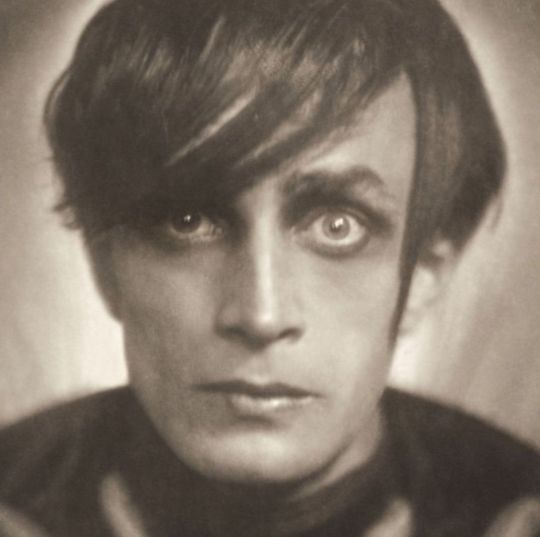
Propaganda
Peter Falk (The Great Race, Robin and the 7 Hoods)—let me just quote Frank Capra: "the entire production was agony ... except for Peter Falk. He was my joy, my anchor to reality. Introducing that remarkable talent to the techniques of comedy made me forget pains, tired blood, and maniacal hankerings to murder Glenn Ford (the film's star)." i also just find scrungly little guys to be the peak of attraction.
Conrad Veidt (The Cabinet of Dr. Caligari, The Man Who Laughs)—the ultimate goth boy! as well as classics like the cabinet of dr caligari, the man who laughs (which his character in was the visual inspiration for the joker) and casablanca, he starred in the german polemic melodrama different from the others in 1919 in one of the first sympathetic portrayals of gay characters in cinema, co-written by the gay researcher & activist magnus hirschfeld much of whose pioneering research on human sexual diversity was destroyed by the nazis
This is round 3 of the bracket. All other polls in this bracket can be found here. Please reblog with further support of your beloved hot sexy vintage man.
[additional propaganda submitted under the cut]
[editor's note: I received such an enormous volume of propaganda for Veidt I could only include some of it here—and unfortunately Tumblr isn't letting me repost any gifs at all, which I didn't expect! Please don't be offended if something you sent in didn't make the cut.]



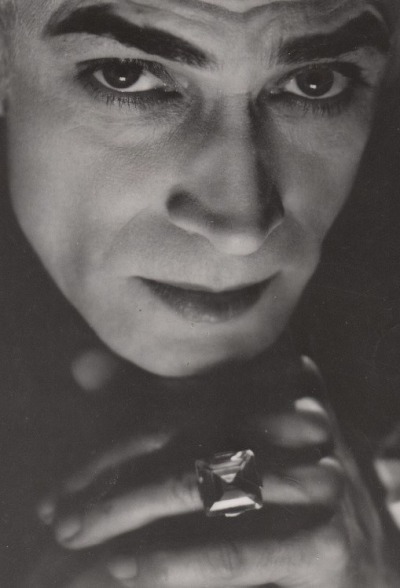


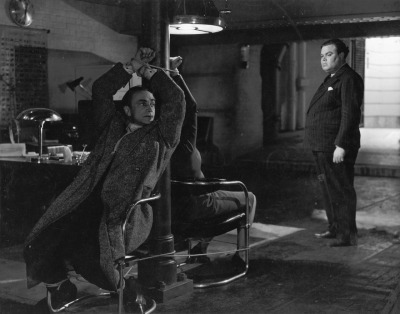
"Just look at him your honor. Ich würde"
Submitted: Tumblr thread on Veidt
Submitted: Tumblr post on Veidt
Peter Falk propaganda:

"listen Peter Falk saved the day for me in robin in the 7 hoods. he saved me in it's a mad mad mad mad world. he damn right resuscitated me in the great race. every movie this man is in is made better by his presence and he should eat the competition alive."
Submitted: "1:56:30 on for Peter Falk's ass in It's a Mad, Mad, Mad, Mad World. yes he falls off a building yes he drives a cab yes he hates the cops"
1K notes
·
View notes
Text



... in Strangerville 🌵 | next
#the sims 4#sims 4#ts4#sims 4 screenshots#ts4 screenshots#ts4globetrotter#globetrotter challenge#ts4 globetrotter#round 3#strangerville#sims 4 strangerville#the worst edit you'll ever see#sims 4 edit#poor stone#😭
273 notes
·
View notes
Text


Reblog for a bigger sample size.
#south park#stan marsh#kyle broflovski#style#stan x kyle#stan VS kyle#if you will#tcbt24#tcbt#character polls#character tournament#round 3
279 notes
·
View notes
Text
Battle of the Captains
Round 3 Part 4 Poll 2


Propaganda
Ed's a master tactician! He's a terrible flirt! He's got the eyes, the beard, the fit, and the sexy lil voice! Tummy and arm! He's gay and has daddy issues! What more could you want from a man???
Jonny's the self-proclaimed captain of the starship Aurora (though everyone else calls him the first mate), and one of the lead singers in The Mechanisms, a spacefaring cabaret of immortal pirates with lovely voices and extremely gray morals. He hails from New Texas, he's got a heart made of metal, and he likes to play the harmonica and shoot things.
#battle of the captains#tournament polls#round 3#ed blackbeard#ed teach#edward teach#ed ofmd#ofmd edward teach#ofmd ed teach#captain blackbeard#ofmd blackbeard#blackbeard ofmd#ofmd fandom#ofmd tag#ofmd#our flag means death#jonny dville#jonny d'ville#the mechs#the mechanisms#bandblr#musicblr
2K notes
·
View notes
Text
Round 3 - Reptilia - Podicipediformes




(Sources - 1, 2, 3, 4)
Our next order of birds are the Podicipediformes, commonly known as “grebes”. They are composed of one family, Podicipedidae, and 6 living genera containing 22 species.
Grebes are aquatic birds, though they do not have webbed feet, instead having lobes that come out the side of each toe. They cannot fly well, and they prefer to escape predators by diving under the water and swiftly swimming away. Their feet are set far back on their bodies, making them well suited for paddling and diving, but not for walking on land. Most species can not walk on land and spend their entire lives in the water. Grebes can be found on every continent except Antarctica, and usually reside in freshwater habitats during the warmer months, some migrating to marine habitats along the coast in the Winter. Those that can fly only do so at night to avoid being detected by predators. Most grebes eat aquatic invertebrates such as crayfish, while some larger grebes have long, spear-like bills adapted for catching and feeding on fish and amphibians.
Grebes are perhaps most famous for their elaborate courtship displays, which involve the pair performing synchronized duets and dances on the water’s surface. Some species do a "penguin dance" where the male and female stand upright, breast posturing out while they run along the water's surface, in a display of athleticism and agility (see gif below the read more). Some species perform a "weed dance" in which both partners hold pieces of aquatic vegetation in their bills. There is also the "weed rush" in which partners swim towards each other, necks stretched out with plants in their bill, and just before colliding position themselves upright and then swim in parallel. If the female decides the male has danced well, they will mate on floating vegetation. Females lay two to seven eggs on a floating nest, either at the water’s edge or anchored to reeds some distance from shore. If the parents have to leave the nest for a time, they will cover the eggs in weeds to hide them. Incubation can last nearly a month. Once the whole nest has hatched, the chicks climb on one of their parent's backs, as they do not quickly take to the water as well as waterfowl. Both parents take care of rearing their young. One parent usually dives for food while the other carries the young on the surface. After four weeks the chicks begin learning to swim, but will still return to their parents’ backs for safety.
Grebes belong to the clade Mirandornithes, which they share with flamingos. Basal members of Mirandornithes, such as Juncitarsus, existed in the Eocene before the two orders diverged, but it is not known when the split occurred as transitional grebe fossils are rare. True grebes do not appear in the fossil record until the Late Oligocene or Early Miocene, around 23–25 million years ago.
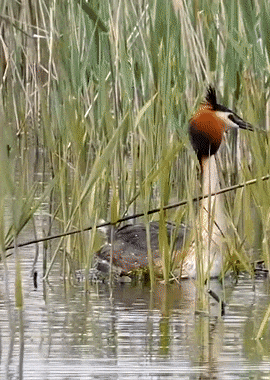
Propaganda under the cut:
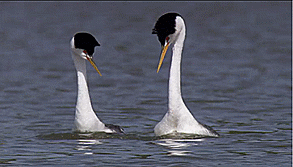

Some grebes eat their own feathers to aid in digestion, as the soft feathers will protect their digestive system from sharp fish bones and invertebrate exoskeletons, and also act as a filtering “plug” to hold bones in place until digestion. They will even feed feathers to their young.
Pied-billed Grebe (Podilymbus podiceps) (image 4) feathers were formerly used as decorations on hats and earmuffs, and they were hunted in the Eastern United States in the 19th century.
Ecologist Anne LaBastille documented the decline of the Atitlán Grebe (Podilymbus gigas) over a period of 25 years. The Atitlán Grebe was a large, flightless grebe that looked like a giant Pied-billed Grebe. The decline of the Atitlán Grebe began in 1958 after Smallmouth Bass (Micropterus dolomieu) and Largemouth Bass (Micropterus salmoides) were introduced into Lake Atitlán for fishermen to catch. These invasive species reduced the crabs and fish which the grebes depended on for food and killed grebe chicks. The population of the Atitlán Grebe declined from 200 individuals in 1960 to 80 in 1965. Anne LaBastille made efforts to establish a refuge in 1966, where the species was able to rebound. Unfortunately, after the 1976 Guatemala earthquake, the refuge’s lake bed fractured and began to drain. By 1983 only 32 individuals were left, many of which were hybrids with the Pied-billed Grebe. The last two birds were seen in 1989, and it was declared extinct by 1990. The same fate happened to the Colombian Grebe (Podiceps andinus) in 1977, and the Alaotra Grebe (Tachybaptus rufolavatus) of Madagascar in 2010, also due to the introduction of invasive fish and loss of habitat. Lake-dwelling grebes are especially vulnerable to extinction as they usually only live in one or a few lakes, and are not quickly able to disperse elsewhere.
The Least Grebe (Tachybaptus dominicus) is the smallest species of grebe, ranging from 21–27 cm (8.3–10.6 in) long and weighing 112–180 g (4.0–6.3 oz). They have a breeding call which has been compared to the sound of a horse whinnying.
Western Grebes (Aechmophorus occidentalis) have a “ticking” alarm call that is only used to signal to their chicks that danger is near. If on their parents’ backs, the chicks will hide their heads and go silent. If the chicks are old enough to be in the water, they may dive and swim away to hide.
The Horned Grebe (Podiceps auritus) (image 1) has 4 pair-bonding ceremonies: the discovery ceremony, the weed ceremony, the head-shaking ceremony, and the triumph ceremony. The discovery ceremony begins with advertising displays, which include an upright posture, erect "horns" and sounding their advertising call. Then, they will both engage in bouts of penguin dance and preening. The discovery ceremony is to ensure correct species identification, sex, and compatibility. The weed ceremony follows the completion of a successful discovery ceremony. The male and female will dive, retrieve weeds, and rise in synchronisation. The pair will come breast-to-breast with their weeds then turn side by side to continue swimming. The weed rush can continue multiple times until both individuals are satisfied. Finally, the head-shaking ceremony and triumph ceremony are performed for primarily established pairs.
The critically endangered Hooded Grebe (Podiceps gallardoi) is most threatened by the American Mink (Neogale vison), which was introduced to Argentina after the minks escaped or were released from fur farms. Between 2010 and 2011, when the minks were first introduced, they killed more than half the adults in a breeding colony of two dozen nests. Between 2012 and 2013, just one mink killed 15 adults and 7 juveniles at El Cervecero and 10 adults and 5 chicks at the C199 colony in La Siberia plateau. They are also threatened by the overgrazing of domestic sheep (which leads to erosion), territorial Flying Steamer Ducks (Tachyeres patachonicus), and predation by Kelp Gulls (Larus dominicanus).
Around 30% of grebe species are threatened, as they are shy birds particularly sensitive to human disturbance. Boats, even just the waves from them, may destroy floating grebe nests or scare the parents enough to cause them to abandon the nest. They are vulnerable to habitat loss, entanglement in fishing nets, and the introduction of invasive species such as predatory fish.
57 notes
·
View notes
Text
@doyoulikethissong-poll
“Genuinely love the idea. After the poll is over, the song's title and artist get revealed, and you can find a lot of cool music that way.”
@one-time-i-dreamt
“people sometimes dont read the URL and think that the dream is something that actually happened. creates confusion and the funny”
5K notes
·
View notes
Text



(Ford)
#stanley pines#stan pines#gf#gravity falls#poll#smash or pass#smash or pass poll#tumblr polls#old man#round 3#67.5
167 notes
·
View notes


